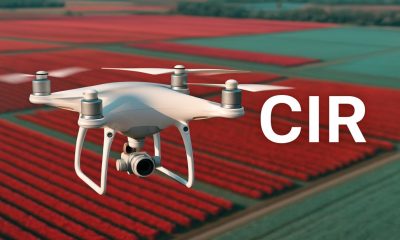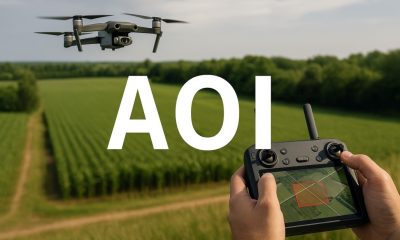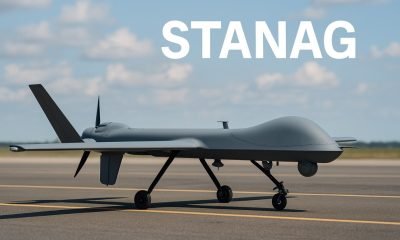- Acronym Guide
- AAM
- ABS
- AC
- ACAS
- ADS-B
- AFAC
- AGL
- AI
- AIM
- ALS
- AM
- AMA
- ANSP
- AOI
- APPI
- AUV
- AUVSI
- ARPAS-UK
- ASTM
- ATC
- BVLOS
- CAA
- CAAC
- CAB
- CASA
- CATT
- CBO
- CBR
- CBRN
- CDMA
- CDR
- CFR
- CIR
- COA
- COMINT
- CORS
- COTP
- COTR
- CPTED
- CV
- C2
- DAA
- DEM
- DFI
- DFS
- DGCA
- DHS
- DOD
- DPA
- DPEs
- DRG
- DRO
- DSM
- DSMX
- DSP
- DSSS
- DTM
- EASA
- EFT
- EO
- EOD
- EO/IR
- ELINT
- EMI
- ESC
- EVLOS
- eVTOLs
- FAA
- FCC
- FCS
- FHSS
- FICCI
- FLIR
- FOB
- FOV
- FPS
- FPV
- GBDAA
- GCP
- GCS
- GDPR
- GML
- GNSS
- GPS
- GSD
- GVC
- HDR
- HOGE
- IACRA
- ICAO
- ICS
- IMU
- INS
- IR
- ISA
- ISR
- ITU
- JARUS
- LAAMS
- LAANC
- LAATM
- LAI
- LBA
- LIDAR
- LOS
- LSALT
- MAC
- MAVLink
- MLIT
- MMS
- MSL
- MTOM
- NDAA
- NCSL
- NFZ
- NIST
- NMEA
- NOTAM
- NPA
- NPRM
- NTIA
- OBIA
- OEM
- OFDM
- OOP
- PASM
- PAV
- PCV
- PdM
- PEC
- PIC
- PID
- PIPL
- PLD
- PM
- PN
- PPK
- PPS
- PSM
- PWM
- UAM
- UAOP
- UAS
- UASTM
- UAV
- UCAVs
- UHD
- UHF
- USV
- UTM
- RAIM
- RCC
- RCS
- RFI
- ReOC
- RePL
- RMS
- ROI
- RPAS
- RPC
- RTH
- RTK
- SaR
- SAR
- SARP
- SBAS
- S.Bus
- SBIR
- SEDENA
- SfM
- SFOC
- SIGINT
- SLAM
- SMS
- SORA
- STANAG
- STTR
- sUAS
- TCAS
- TCCA
- TFR
- TIN
- TOF
- TP
- TPS
- TSA
- VHF
- VLOS
- VTOL
Drone Acronyms
What is EO/IR (Electro-Optical/Infrared) & How Does it Work?
By
Jacob StonerTable Of Contents

Definition
EO/IR refers to Electro-Optical and Infrared sensor systems used for imaging and surveillance. EO sensors operate in the visible and near-infrared spectrums (similar to standard cameras), while IR sensors detect heat signatures emitted by objects and are typically used for thermal imaging. Together, EO/IR payloads allow drones to capture detailed visual and thermal data for situational awareness in day or night conditions.
Usage
EO/IR systems are widely used in drone operations for applications such as search and rescue, security surveillance, wildfire monitoring, infrastructure inspection, and military reconnaissance. The EO camera captures high-definition imagery, while the IR sensor reveals heat differences—such as human bodies, electrical faults, or structural hotspots.
Relevance to the Industry
EO/IR technology enhances drone capabilities by enabling all-weather, day-and-night functionality. It plays a critical role in time-sensitive missions, such as locating missing persons, assessing overheating equipment, or navigating reduced visibility conditions. These systems are standard in public safety drones, industrial inspection fleets, and defense-grade UAVs.
How Does EO/IR (Electro-Optical/Infrared) Work?
EO/IR systems work by integrating two types of sensors—electro-optical and infrared—into a single payload, allowing drones to capture both visual and thermal imagery in real time. This fusion of data helps operators interpret complex environments, detect hidden threats, or identify patterns that would otherwise go unnoticed. Here’s how the system functions:
Sensor Integration
EO/IR payloads typically consist of:An EO (Electro-Optical) camera, which captures high-resolution images or video in the visible and near-infrared spectrum.
An IR (Infrared) sensor, often a thermal imager, which detects the heat emitted by objects and generates a heat map or thermal signature.
Simultaneous Data Capture
Both EO and IR sensors operate in parallel, capturing different perspectives of the same scene. For example, while the EO sensor records surface detail such as cracks or features, the IR sensor reveals heat anomalies, human presence, or overheating components.Image Processing and Fusion
The onboard processor or ground control software may combine EO and IR data into a fused view, allowing the operator to see heat signatures overlaid on top of the visual imagery. This enhances interpretation and speeds up decision-making.Zoom, Tracking, and Target Detection
Most EO/IR systems include pan-tilt-zoom (PTZ) capabilities for tracking objects and zooming into points of interest. AI-assisted detection may automatically identify and lock onto heat sources, making it easier to follow moving targets like people or vehicles.Live Transmission and Storage
The combined data is streamed to the operator in real time, allowing immediate action. Data is also recorded for post-flight analysis, reporting, or evidence collection in sectors like public safety and utilities.
By providing both visual and thermal insight, EO/IR systems give drones powerful situational awareness capabilities—especially useful in low-visibility, nighttime, or complex inspection environments.
Example in Use
“The drone’s EO/IR system quickly identified a heat signature beneath rubble, guiding emergency responders to a trapped survivor.”
Frequently Asked Questions about EO/IR (Electro-Optical/Infrared)
What is the difference between EO and IR sensors?
Answer:
EO (Electro-Optical) sensors capture images using visible and near-infrared light—similar to traditional cameras.
IR (Infrared) sensors detect thermal radiation, providing heat maps and thermal signatures invisible to the naked eye.
How are EO/IR systems used in drone operations?
Answer:
Search and Rescue: Detecting people via heat in low-light or obstructed environments.
Inspections: Identifying overheating components in power lines, solar panels, or industrial equipment.
Surveillance and Defense: Monitoring activity with live thermal and visual feeds.
Firefighting: Pinpointing hot spots during wildfire monitoring or urban fires.
What are the advantages of using EO/IR sensors on drones?
Answer:
Versatility: Operates effectively in both daylight and complete darkness.
Non-Invasive: Collects data without physical contact or disturbance.
Enhanced Accuracy: Combines visual and thermal data for comprehensive analysis.
Real-Time Decision Making: Provides immediate situational feedback to operators.
For examples of these acronyms visit our Industries page.
As the CEO of Flyeye.io, Jacob Stoner spearheads the company's operations with his extensive expertise in the drone industry. He is a licensed commercial drone operator in Canada, where he frequently conducts drone inspections. Jacob is a highly respected figure within his local drone community, where he indulges his passion for videography during his leisure time. Above all, Jacob's keen interest lies in the potential societal impact of drone technology advancements.











